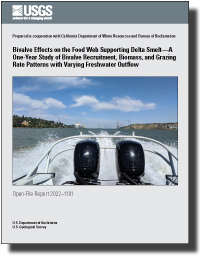Bivalve Effects on the Food Web Supporting Delta Smelt—A One-Year Study of Bivalve Recruitment, Biomass, and Grazing Rate Patterns with Varying Freshwater Outflow
Links
- Document: Report (5 MB pdf)
- Related Work: Open-File Report 2022-1102 - Bivalve Effects on the Food Web Supporting Delta Smelt—A Spatially Intensive Study of Bivalve Recruitment, Biomass, and Grazing Rate Patterns with Varying Freshwater Outflow in 2019
- Data Release: Bivalve metrics in the North San Francisco Bay and Sacramento-San Joaquin Delta
- Download citation as: RIS | Dublin Core
Abstract
Phytoplankton are an important and limiting food source in the Sacramento-San Joaquin Delta and San Francisco Bay in California. Decreasing phytoplankton biomass is one possible factor for the pelagic organism decline and the decline of the protected Hypomesus transpacificus (delta smelt). Bivalves Corbicula fluminea and Potamocorbula amurensis (hereafter C. fluminea and P. amurensis, respectively) have been shown to control phytoplankton biomass throughout San Francisco Bay and the Sacramento-San Joaquin Delta; therefore, their distribution and population dynamics are of great interest.
We describe the distribution and dynamics of bivalve biomass using samples from California Department of Water Resources’ (DWR) 2019 benthic monitoring program. As one element of DWR’s and the Bureau of Reclamation’s Environmental Monitoring Program (EMP), the DWR benthic monitoring program examines the effect of water project operations on the estuary as prescribed by a series of Water Rights Decisions mandated by the California State Water Resources Control Board (SWRCB).
The biomass and grazing rate values of both bivalves had similar patterns, therefore, comments on biomass distribution can be applied to grazing rate data. Biomass and recruitment values of C. fluminea were too low at station C9 (Old River upstream from Clift on Court Forebay Intake) to describe a temporal pattern. Corbicula fluminea biomass values were consistently high at station D24 (Sacramento River). Station D4L (confluence of San Joaquin and Sacramento Rivers) biomass values were low during the first half of the year and high the rest of the year. Corbicula fluminea biomass values at station P8 (San Joaquin River) were the highest and most consistent on that river. Station D16 (San Joaquin River) and station D28A (central delta) biomass values were near zero with a small peak in May.
Potamocorbula amurensis biomass values were near zero at station D4L (confluence of San Joaquin and Sacramento Rivers). Biomass values were strongly seasonal at station D6 (Suisun Bay). Station D41 (San Pablo Bay) had the highest P. amurensis biomass values. Station D7 (Grizzly Bay) and station D41A (San Pablo Bay) had low biomass values in January-June or July and maximum biomass values in August.
Corbicula fluminea recruits in the Sacramento River stations peaked twice, from January to June and from September to December. At the San Joaquin River stations, C. fluminea recruitment peaked from May to July or August and from November to December. Peak recruit abundance was higher on the Sacramento River than the San Joaquin River.
Potamocorbula amurensis recruitment was more seasonal than C. fluminea, with a high number of recruits followed by periods with no recruits. Station D4L had few recruits except in January. Station D6 had low recruitment from January to February, increased in August, and peaked from November to December. Station D7 had fewer recruits than station D6 but had a similar temporal pattern, although winter recruits continued into April instead of February. Station D41 recruits were sparce and present only from May to July. Station D41A had the most recruits from January to July, and again in September.
Suggested Citation
Zierdt Smith, E.L., Shrader, K.H., Thompson, J.K., Parchaso, F., Gehrts, K., and Wells, E., 2023, Bivalve effects on the food web supporting delta smelt—A long-term study of bivalve recruitment, biomass, and grazing rate patterns with varying freshwater outflow: U.S. Geological Survey Open-File Report 2022–1101, 13 p., https://doi.org/10.3133/ofr20221101.
ISSN: 2331-1258 (online)
Study Area
Table of Contents
- Acknowledgements
- Abstract
- Introduction
- Methods
- Results
- Conclusions
- References Cited
| Publication type | Report |
|---|---|
| Publication Subtype | USGS Numbered Series |
| Title | Bivalve effects on the food web supporting delta smelt—A long-term study of bivalve recruitment, biomass, and grazing rate patterns with varying freshwater outflow |
| Series title | Open-File Report |
| Series number | 2022-1101 |
| DOI | 10.3133/ofr20221101 |
| Publication Date | April 13, 2023 |
| Year Published | 2023 |
| Language | English |
| Publisher | U.S. Geological Survey |
| Publisher location | Reston, VA |
| Contributing office(s) | WMA - Earth System Processes Division |
| Description | Report: vi, 13 p.; Data Release |
| Country | United States |
| State | California |
| Other Geospatial | Sacramento–San Joaquin Delta |
| Online Only (Y/N) | Y |


